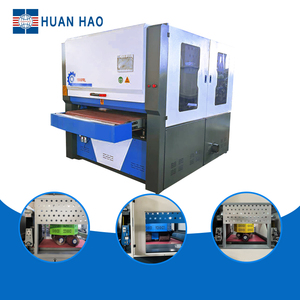
All categories
Featured selections
Trade Assurance
Buyer Central
Help Center
Get the app
Become a supplier

(1565 products available)




















An automatic chamfering machine is designed to create beveled edges on various materials, including metal, wood, plastic, and other solid surfaces. The specific types and works of an automatic chamfering machine vary according to the material used and applications.
Metal automatic chamfering machine:
Metal automatic beveling machines are designed to professionally bevel edges of metal sheets, pipes, and plates, thereby providing smooth and clean edges. They come in various styles, most of which have their feature and function.
Automatic metal beveling machines: These are typically used for the edge preparation of welding in steel plates. They use grinding wheels, milling cutters, or abrasive belts to create bevels on the edges of metal workpieces. Some automatic metal chamfering machines (like CNC beveling machines) come with digital controls that allow operators to set bevel angle precisely, while others are mostly used for edge preparations for welding.
Pipe beveling machines: Also known as automatic pipe chamfering machines, these machines are mainly used to prepare beveled edges on pipe ends. Depending on the design and construction, they may use milling cutters or grinding wheels to create bevels on the pipe ends. Pipe beveling machines come in various styles, including portable, standard, and automatic.
Handheld beveling tools: This is another prominent type of metal automatic chamfering; they are small-sized, portable machines, which, as the name implies, are mostly operated by hand. Like other beveling machines that are operated manually, handheld beveling tools are designed for smaller-scale beveling tasks.
Non-metal automatic chamfering machines:
Non-metal automatic chamfering machines are commonly used for solid workpieces made of material other than metal. They use milling cutters or diamond bits to create the desired bevels. Non-metal automatic beveling machines also come in various designs; inline beveling machines and CNC chamfering machines are two common setups.
Inline beveling machines are typically used for high-accuracy inline beveling of solid workpieces. They can be integrated into existing production lines and typically use a milling cutter to create the desired chamfer.
CNC chamfering machines, on the other hand, are programmed or controlled by computer software, which allows users to set bevel angle, depth, and other parameters precisely. This feature not only ensures consistent beveling results but also improves the efficiency and automation of the beveling process.
The specifications of an automatic beveling machine for sale will vary depending on the type of machine the buyer is interested in.
To maintain any automatic chamfering device for sale, manufacturers recommend the following:
Metalworking industry
The metallurgy sector employs automatic chamfering machines for metal pipes, angles, flats, channels, beams, and H/I steel. In this context, V-type and C-type chamferers are most commonly used. The metallurgy sector needs automatic chamfering machines to accomplish various tasks, like cutting and chamfering at a single pass. Nevertheless, all automatic chamfering machines work towards achieving one goal: to make metal work easier.
Construction
In the construction industry, the automatic chamfering machine is typically used to prepare the edges of concrete and masonry elements. These may include beams, columns, slabs, and foundations. The machine is employed to create bevels or rounded edges on the borderlines of these structural components. This is often done to facilitate the removal of formwork (amesh that holds the liquid concrete in place during curing) or to enhance the aesthetics of the finished structure.
Plumbing
In plumbing, an automatic chamfering machine is commonly used for pipe preparation. It is used to bevel the edges of pipes, such as PVC, CPVC, or other plastic pipes, before joining or welding. The beveling improves the quality of the joint and ensures a better fit and seal.
Shipbuilding
In the shipbuilding industry, automatic chamfering machines are commonly used for hull plate preparation. These machines are employed to bevel the edges of hull plates, which are the structural components that make up the body's outer shell of a ship. The beveling ensures proper fit and alignment of the plates during assembly and welding.
Automotive
In the automotive industry, automatic chamfering machines are used to process various components. Some machine models are designed for rotor or drum automatic chamfering, while others feature a multi-station CNC (Computerized Numerical Control) design that allows them to handle more than 20 different parts. These components may include valves, gearbox parts, brackets, pump parts, bearing seats, transmission components, propellers, and more. The use of automatic chamfering machines in automotive manufacturing helps ensure precise machining and quality of critical automotive parts.
Consider the following factors before purchasing an industrial automatic chamfering machine:
Q1: Do automatic chamfering machines work on all materials?
A1: No, not all. Some machines are built to work on specific materials like metal, wood, or stone. Chamfering machines designed for metal will work on various types of metal, including alloys, stainless steel, and carbon. Chamfering machines for wood can only work on wooden products, and those built for stones will only work on marble or granite products.
Q2: Do automatic metal chamfering machines have a maximum thickness?
A2: Yes. The metals' thickness an automatic metal chamfering machine can bevel depends on its size. Larger, industrial-sized machines can chamfer heavy metal sections like pipelines, bridges, and structural frameworks. Under such heavy requirements, using a heavy automatic metal chamfering machine will be ideal. On the other hand, smaller machines are perfect for thinner metals like steel plates or stainless steel sheets.
Q3: Can someone change the bevel angles when using an automatic chamfering machine?
A3: Most modern automatic chamfering machines have features that allow operators to change bevel angles and widths according to their specifications. They also have digital controls that provide precision and accuracy when beveling different parts.
Q4: Can someone bevel more than one edge simultaneously in an automatic chamfering machine?
A4: Yes. Some automatic chamfering machines are designed to bevel multiple edges simultaneously. These machines are ideal for large-scale production as they work more efficiently than those that bevel only one edge at a time.